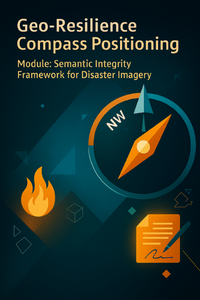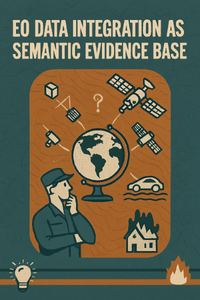Northwest (NW) 🧭 System Coherence & Communication Architectures
Coherence does not arise from uniformity, but from the resilient connection of diverse logics. The northwestern zone of the Geo-Resilience Compass focuses on the alignment of technical and organizational interfaces, the design of robust information flows, the navigation of uncertainty and ambiguity and semantic connectivity across diverse contexts.
Earth Observation (EO) is understood here as an architecture-supporting tool: It can contribute to spatially structuring information flows, making interfaces between systems visible and building semantic bridges between local, technical and organizational contexts – not through uniformity, but through structured openness.
The modules and concepts developed here aim to:
- align technical and organizational interfaces in ways that remain interoperable and responsive under stress
- design robust information flows that do not eliminate uncertainty, but make it navigable
- understand ambiguity and uncertainty as integral components of resilient communication
- enable semantic connectivity across disciplinary, cultural and systemic boundaries
This compass zone stands for coherence through structural intelligence – creating conditions for understanding, interoperability and adaptive steering, supported by EO and anchored in a logic that does not unify, but connects.
Strategic Embedding within the Geo-Resilience Compass
This publication introduces Version 1.0 of the Semantic Integrity Framework for Disaster Imagery — a strategic module embedded within the overarching Geo-Resilience Framework. It was developed as part of the Geo-Resilience Compass, a strategic navigation instrument designed to provide orientation in complex spatio-temporal crisis environments. The compass structures resilience across eight thematic axes, anchored by a central decision-making backbone. The framework presented herein is primarily situated along the Northwest axis (System Coherence & Communication Architectures). It reinforces the semantic integrity of visual communication, strengthens interfaces between technology, ethics, and governance and enables transparent decision-making logic in highly dynamic operational contexts.
Geo-Resilience Compass Positioning
Module: Semantic Integrity Framework for Disaster Imagery
Primary Compass Category: Northwest (NW) – System Coherence & Communication Architectures
Strategic Function within the NW Axis
NW Compass Dimension Correspondence in the Framework
NW Compass Dimension | Correspondence in the Framework |
Technical-organizational interfaces | SP1–SP5 as a modular architecture for semantic image verification |
Robust information flows | API interface with auditable access control and semantic release logic |
Navigating uncertainty and ambiguity | Semantic Drift Detection for identifying shifts in meaning |
Semantic connectivity | Multilingual adaptability, symbol protection, narrative coherence validation |
Source: Own representation based on strategic function assignment within the Semantic Integrity Framework for semantic navigation along the NW compass dimensions (October 2025)
Secondary Compass Linkages
Although the primary positioning lies within the Northwest axis, this framework also offers strategic cross-linkages to other compass directions:
NE – Early Warning Systems & Risk Detection
→ EO/GIS integration in SP4.1 for semantic validation of crisis imagery
SW – Local Continuity & Community Reconnection
→ Protection of culturally sensitive content and semantic contextualization
Center – Resilience Backbone
→ SOP compatibility, reflexive decision-making logic, governance embedding
Positioning Summary
The Semantic Integrity Framework functions as a strategic navigation instrument for semantic resilience. It enhances the capacity to operate with visual coherence, ethical anchoring and technical interoperability in complex crisis environments.
We are currently creating content for this page. In order to meet our own high quality standards, we still need a little time.
Please visit this page again soon. Thank you for your interest!
This contribution was authored by Birgit Bortoluzzi, strategic architect and certified Graduate Disaster Manager. The content reflects original interdisciplinary synthesis developed within the framework of the Geo-Resilience Initiative.

